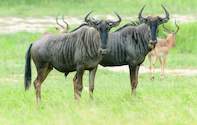
Every October for the last three years the Sabi-Sand Wildtuin (SSW) has released about 600 wildebeest into their 65,000ha reserve, but despite the re-introduction of almost 1,800 animals the last estimate of wildebeest numbers on the reserve showed a mere 400 animals.
What is happening with the wildebeest? This question has been asked numerous times over the last few decades, not only by the Sabi-Sand's management, but also by the Kruger National Park (KNP).
During the 20th century, wildebeest numbers have fluctuated a lot in the Sabi-Sand and the adjoining western section of Kruger, but when the numbers of wildebeest in the SSW reached an all-time low of 75 animals in 2003 management stepped in and started reintroducing wildebeest in big numbers.
Looking back in time, the Sabi-Sand's wildebeest population was once joined with that of the Kruger Park. Research conducted by Dr Ian Whyte showed that in the central region of Kruger, there were three main wildebeest sub-populations.
One of these groups of wildebeest used to conduct an annual trek between Kruger and adjoining private conservation areas, including the Sabi-Sand. The wildebeest used to move north and west in summer to take advantage of good grazing in the privately owned land, having calves there before moving back into Kruger in winter to be near more permanent natural water sources.
When foot and mouth outbreaks caused Kruger to be fenced off in the 1960s, these wildebeest were hard hit as they could no longer make their annual migration. Despite the addition of artificial waterpoints to try and open up new grazing areas in Kruger the wildebeest numbers in this section of the park dropped by almost 90 percent, and never really picked up again.
The remainder of the once-migratory population ended up staying in the areas of the veld that best suited their grazing needs, and although their numbers stabilised there were never as many wildebeest in the subpopulation as before. The numbers of animals in the other two sub-populations also rose and fell, but this was more in line with natural fluctuations caused by cyclical changes in rainfall patterns. On the other side of the fence in the Sabi-Sand, one of the landowners, ................
Varty, remembers that there were about 3,000 wildebeest in the reserve at the time the Kruger fence went up. These numbers also crashed in the aftermath of the fencing, with not enough grazing and lions having an easy time finding a meal with such high wildebeest densities trapped by fences.
Eventually numbers stabilised, and for several decades the Sabi-Sand wildebeest numbers hovered around 600-800 animals depending on the rainfall. Several researchers have shown that wildebeest (and to some extent zebra) numbers suffer in years of above-average rainfall, but that they are more successful in drier years.
After decades of having a relatively stable wildebeest population, warning signs started flickering in the 1990s for the Sabi-Sand's management. Every year the annual census showed a decline in wildebeest numbers, with numbers dropping from 571 in 1993 to only 75 in 2003. Interestingly, the fence between Kruger and the Sabi-Sand was taken down in 1993, and there has been some speculation that this is linked to the dwindling wildebeest numbers.
Wildebeest are also one of the meals of choice for lions. With a population of only 75 animals, it was almost inevitable that the lions would polish off the remaining wildebeest in the Sabi-Sand in practically no time, as the wildebeest could not produce enough babies to keep the population going.
With no migration of wildebeest from Kruger, this would have resulted in wildebeest becoming locally extinct in the Sabi-Sand Wildtuin. Having kept their eye on the numbers for several years, the management of the reserve then stepped in with their strategy to save the wildebeest.
In a good example of sustainable utilisation, the reserve exchanged rhino for wildebeest with reserves in Swaziland. The reserve has a thriving rhino population which has bred so well that there is almost an over-population of rhino on the reserve. With rhino fights breaking out over territory and rhino breaking fences in search of greener pastures, the removal of a few animals in exchange for wildebeest was a win-win situation.
The first load of almost 600 wildebeest was released in September 2003, followed by similar releases in 2004 and 2005. Since 2004, reserve ecologist Jonathan Swart has been monitoring wildebeest numbers with the help of annual aerial censuses and monthly reports from the many lodges in the Sabi-Sand. All the lodges in the reserve are contributing to keeping statistics on the wildebeest. They report sightings of both wildebeest and lion kills to Jonathan.
By looking at these two things, Jonathan can see where the wildebeest are moving around, and also how many of the wildebeest the lions are eating. With the addition of about 1,800 wildebeest over three years, one might think that the reserve's wildebeest population would be back on its feet, especially as only about 450 wildebeest have been recorded as being lion lunch, mostly during the few months after the releases. However, the last estimate showed about 400 wildebeest, leaving a bit of a mystery as to where all the other animals went.
Some movement of animals between the Sabi-Sand and Kruger and other adjoining conservation areas has been recorded, with a bit of a migration pattern possibly starting to emerge in the northern parts of the reserve.
Despite the difference between the numbers of introduced animals and those seen on the ground, the Sabi-Sand has seen a definite upward trend in wildebeest numbers. The reserve is hopeful when the annual census is conducted this September, there will be signs that the wildebeest are starting to breed well enough to keep pace with the lions' appetite.
Read more about the Wildlife of Sabi Sands Game Reserve
By Melissa Wray

